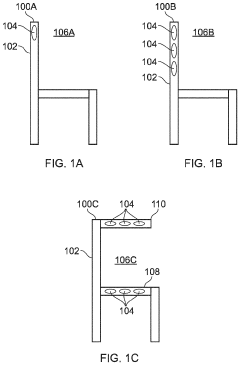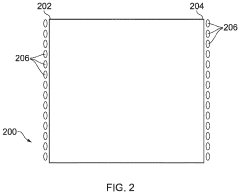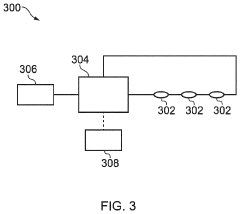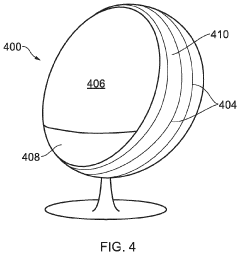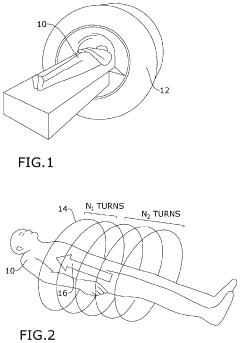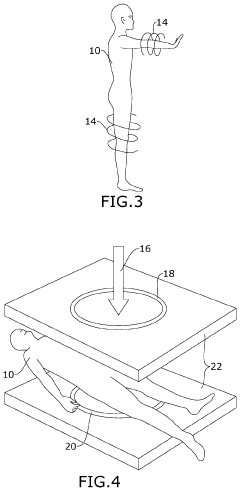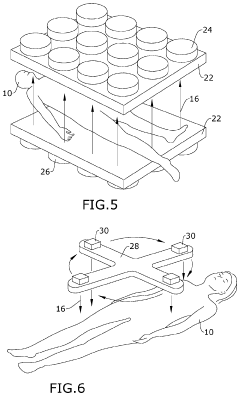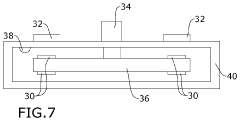Schumann Resonance: Key Component of Earth’s Electromagnetic System
JUN 24, 20259 MIN READ
Generate Your Research Report Instantly with AI Agent
Patsnap Eureka helps you evaluate technical feasibility & market potential.
Schumann Resonance Background and Objectives
Schumann resonances, discovered by physicist Winfried Otto Schumann in 1952, are a set of spectrum peaks in the extremely low frequency (ELF) portion of the Earth's electromagnetic field spectrum. These resonances occur between the Earth's surface and the ionosphere, forming a natural cavity resonator. The fundamental frequency of Schumann resonances is approximately 7.83 Hz, with harmonics at higher frequencies.
The study of Schumann resonances has gained significant attention in recent years due to its potential applications in various fields, including geophysics, atmospheric science, and even human health. As a key component of Earth's electromagnetic system, Schumann resonances play a crucial role in understanding the planet's electromagnetic environment and its interactions with various natural phenomena.
The primary objective of researching Schumann resonances is to gain a comprehensive understanding of their characteristics, variations, and potential applications. This includes investigating the factors that influence the resonances, such as solar activity, lightning activity, and changes in the ionosphere. By studying these resonances, scientists aim to develop more accurate models of the Earth's electromagnetic field and improve our ability to predict and monitor global atmospheric and ionospheric conditions.
Another important goal is to explore the potential applications of Schumann resonances in various fields. For instance, researchers are investigating the use of Schumann resonances as a tool for monitoring global lightning activity and tracking severe weather patterns. Additionally, there is growing interest in studying the potential effects of Schumann resonances on human health and well-being, with some researchers suggesting a connection between these natural electromagnetic frequencies and biological rhythms.
The technological advancements in recent years have significantly improved our ability to measure and analyze Schumann resonances. The development of highly sensitive magnetometers and sophisticated signal processing techniques has enabled researchers to detect and study these resonances with unprecedented precision. This has opened up new avenues for research and potential applications, including the use of Schumann resonances in global climate monitoring and space weather forecasting.
As we continue to explore the Earth's electromagnetic system, the study of Schumann resonances remains a critical area of research. The ongoing efforts to understand these resonances and their interactions with various Earth systems will likely lead to new insights and applications in the coming years, further cementing their importance in our understanding of the planet's electromagnetic environment.
The study of Schumann resonances has gained significant attention in recent years due to its potential applications in various fields, including geophysics, atmospheric science, and even human health. As a key component of Earth's electromagnetic system, Schumann resonances play a crucial role in understanding the planet's electromagnetic environment and its interactions with various natural phenomena.
The primary objective of researching Schumann resonances is to gain a comprehensive understanding of their characteristics, variations, and potential applications. This includes investigating the factors that influence the resonances, such as solar activity, lightning activity, and changes in the ionosphere. By studying these resonances, scientists aim to develop more accurate models of the Earth's electromagnetic field and improve our ability to predict and monitor global atmospheric and ionospheric conditions.
Another important goal is to explore the potential applications of Schumann resonances in various fields. For instance, researchers are investigating the use of Schumann resonances as a tool for monitoring global lightning activity and tracking severe weather patterns. Additionally, there is growing interest in studying the potential effects of Schumann resonances on human health and well-being, with some researchers suggesting a connection between these natural electromagnetic frequencies and biological rhythms.
The technological advancements in recent years have significantly improved our ability to measure and analyze Schumann resonances. The development of highly sensitive magnetometers and sophisticated signal processing techniques has enabled researchers to detect and study these resonances with unprecedented precision. This has opened up new avenues for research and potential applications, including the use of Schumann resonances in global climate monitoring and space weather forecasting.
As we continue to explore the Earth's electromagnetic system, the study of Schumann resonances remains a critical area of research. The ongoing efforts to understand these resonances and their interactions with various Earth systems will likely lead to new insights and applications in the coming years, further cementing their importance in our understanding of the planet's electromagnetic environment.
Earth's EM System Market Applications
The Schumann Resonance, as a key component of Earth's electromagnetic system, has garnered significant attention in various market applications. This natural phenomenon, occurring in the Earth-ionosphere cavity, has potential uses across multiple industries, driving innovation and creating new market opportunities.
In the field of environmental monitoring, Schumann Resonance measurements are increasingly utilized to detect and analyze global climate changes. The resonance's sensitivity to temperature fluctuations and atmospheric conditions makes it a valuable tool for climate scientists and meteorologists. Companies developing advanced weather prediction systems and climate modeling software are incorporating Schumann Resonance data to enhance the accuracy of their forecasts and long-term projections.
The telecommunications industry has shown growing interest in leveraging Schumann Resonance for improving signal propagation and reducing interference in long-distance communications. By understanding and utilizing the Earth's natural electromagnetic frequencies, researchers are exploring ways to enhance wireless communication technologies, particularly in remote areas or during natural disasters when traditional infrastructure may be compromised.
In the realm of geophysical exploration, Schumann Resonance measurements are being employed to detect subsurface structures and mineral deposits. Mining and oil companies are investing in technologies that use these resonances to complement traditional exploration methods, potentially reducing costs and improving the efficiency of resource discovery.
The healthcare sector is exploring the potential therapeutic applications of Schumann Resonance. Some researchers hypothesize that exposure to these natural frequencies may have beneficial effects on human health, leading to the development of specialized medical devices and wellness products. While scientific evidence is still being gathered, this area represents a growing niche market with potential for expansion.
In the field of space weather prediction, Schumann Resonance monitoring is becoming an essential tool. As our reliance on satellite technology increases, understanding and predicting space weather events that can affect these systems becomes crucial. Companies providing space weather forecasting services are incorporating Schumann Resonance data into their models to improve the accuracy of their predictions.
The emerging field of electromagnetic pollution monitoring is another area where Schumann Resonance research is finding applications. As concerns grow about the potential health impacts of artificial electromagnetic fields, there is increasing demand for technologies that can measure and mitigate these effects. Schumann Resonance-based devices are being developed to assess electromagnetic pollution levels and create "cleaner" electromagnetic environments.
These diverse market applications demonstrate the growing recognition of Schumann Resonance as a valuable component in Earth's electromagnetic system, with potential to drive innovation across multiple industries and create new market opportunities.
In the field of environmental monitoring, Schumann Resonance measurements are increasingly utilized to detect and analyze global climate changes. The resonance's sensitivity to temperature fluctuations and atmospheric conditions makes it a valuable tool for climate scientists and meteorologists. Companies developing advanced weather prediction systems and climate modeling software are incorporating Schumann Resonance data to enhance the accuracy of their forecasts and long-term projections.
The telecommunications industry has shown growing interest in leveraging Schumann Resonance for improving signal propagation and reducing interference in long-distance communications. By understanding and utilizing the Earth's natural electromagnetic frequencies, researchers are exploring ways to enhance wireless communication technologies, particularly in remote areas or during natural disasters when traditional infrastructure may be compromised.
In the realm of geophysical exploration, Schumann Resonance measurements are being employed to detect subsurface structures and mineral deposits. Mining and oil companies are investing in technologies that use these resonances to complement traditional exploration methods, potentially reducing costs and improving the efficiency of resource discovery.
The healthcare sector is exploring the potential therapeutic applications of Schumann Resonance. Some researchers hypothesize that exposure to these natural frequencies may have beneficial effects on human health, leading to the development of specialized medical devices and wellness products. While scientific evidence is still being gathered, this area represents a growing niche market with potential for expansion.
In the field of space weather prediction, Schumann Resonance monitoring is becoming an essential tool. As our reliance on satellite technology increases, understanding and predicting space weather events that can affect these systems becomes crucial. Companies providing space weather forecasting services are incorporating Schumann Resonance data into their models to improve the accuracy of their predictions.
The emerging field of electromagnetic pollution monitoring is another area where Schumann Resonance research is finding applications. As concerns grow about the potential health impacts of artificial electromagnetic fields, there is increasing demand for technologies that can measure and mitigate these effects. Schumann Resonance-based devices are being developed to assess electromagnetic pollution levels and create "cleaner" electromagnetic environments.
These diverse market applications demonstrate the growing recognition of Schumann Resonance as a valuable component in Earth's electromagnetic system, with potential to drive innovation across multiple industries and create new market opportunities.
Current State and Challenges in SR Research
Schumann Resonance (SR) research has made significant strides in recent years, with advancements in measurement techniques and data analysis. Currently, a global network of SR monitoring stations exists, providing continuous data on the Earth's electromagnetic environment. These stations utilize highly sensitive magnetometers and electric field sensors to detect the subtle variations in the SR frequencies.
One of the primary challenges in SR research is the isolation of the weak SR signal from background noise. Natural and anthropogenic electromagnetic interference can significantly impact the quality of SR measurements. Researchers are developing advanced signal processing algorithms and noise reduction techniques to address this issue, improving the accuracy and reliability of SR data.
The interdisciplinary nature of SR research presents both opportunities and challenges. While it allows for diverse applications across fields such as atmospheric science, geophysics, and space weather, it also requires collaboration between experts from various disciplines. Coordinating research efforts and integrating findings from different areas can be complex and time-consuming.
Another significant challenge is the limited understanding of the relationship between SR and other geophysical phenomena. While correlations have been observed between SR parameters and various atmospheric and ionospheric processes, the exact mechanisms linking these phenomena are not fully understood. This gap in knowledge hinders the development of comprehensive models that could potentially use SR data for forecasting or monitoring global environmental changes.
The global distribution of SR monitoring stations is uneven, with a concentration in certain regions and gaps in others. This imbalance affects the ability to conduct truly global studies and may introduce biases in the analysis of SR data. Expanding the network to underrepresented areas, particularly in the Southern Hemisphere and over oceans, is a current focus of the research community.
Technological limitations also pose challenges in SR research. The need for more sensitive and stable instruments, capable of detecting minute changes in the Earth's electromagnetic field over extended periods, is ongoing. Additionally, the development of standardized calibration methods and data processing protocols is crucial for ensuring the comparability of measurements from different stations worldwide.
The potential applications of SR research in climate change studies, earthquake prediction, and human health have garnered increased attention. However, translating SR observations into practical applications remains a significant challenge. More research is needed to establish robust links between SR parameters and specific environmental or physiological effects, and to develop reliable predictive models based on SR data.
One of the primary challenges in SR research is the isolation of the weak SR signal from background noise. Natural and anthropogenic electromagnetic interference can significantly impact the quality of SR measurements. Researchers are developing advanced signal processing algorithms and noise reduction techniques to address this issue, improving the accuracy and reliability of SR data.
The interdisciplinary nature of SR research presents both opportunities and challenges. While it allows for diverse applications across fields such as atmospheric science, geophysics, and space weather, it also requires collaboration between experts from various disciplines. Coordinating research efforts and integrating findings from different areas can be complex and time-consuming.
Another significant challenge is the limited understanding of the relationship between SR and other geophysical phenomena. While correlations have been observed between SR parameters and various atmospheric and ionospheric processes, the exact mechanisms linking these phenomena are not fully understood. This gap in knowledge hinders the development of comprehensive models that could potentially use SR data for forecasting or monitoring global environmental changes.
The global distribution of SR monitoring stations is uneven, with a concentration in certain regions and gaps in others. This imbalance affects the ability to conduct truly global studies and may introduce biases in the analysis of SR data. Expanding the network to underrepresented areas, particularly in the Southern Hemisphere and over oceans, is a current focus of the research community.
Technological limitations also pose challenges in SR research. The need for more sensitive and stable instruments, capable of detecting minute changes in the Earth's electromagnetic field over extended periods, is ongoing. Additionally, the development of standardized calibration methods and data processing protocols is crucial for ensuring the comparability of measurements from different stations worldwide.
The potential applications of SR research in climate change studies, earthquake prediction, and human health have garnered increased attention. However, translating SR observations into practical applications remains a significant challenge. More research is needed to establish robust links between SR parameters and specific environmental or physiological effects, and to develop reliable predictive models based on SR data.
Existing SR Measurement Techniques
01 Schumann resonance devices for health and wellness
Various devices are designed to generate or simulate Schumann resonance frequencies for potential health benefits. These devices aim to create an electromagnetic environment similar to the Earth's natural resonance, which some believe can improve well-being, reduce stress, and enhance relaxation.- Schumann resonance devices for health and wellness: Various devices are designed to generate or utilize Schumann resonance frequencies for potential health benefits. These devices aim to simulate the natural electromagnetic frequencies of the Earth to promote relaxation, improve sleep quality, and enhance overall well-being. Some implementations include wearable devices, room-based generators, and portable units that emit Schumann resonance frequencies.
- Schumann resonance in electromagnetic shielding: Schumann resonance principles are applied in the development of electromagnetic shielding materials and structures. These innovations aim to protect electronic devices and living spaces from harmful electromagnetic radiation while maintaining the beneficial effects of natural Earth frequencies. Some designs incorporate Schumann resonance-friendly materials or structures in buildings, vehicles, and personal protective equipment.
- Integration of Schumann resonance in meditation and relaxation tools: Schumann resonance frequencies are incorporated into various meditation and relaxation tools to enhance the user experience. These tools may include audio devices, visual stimulation systems, or combination products that synchronize multiple sensory inputs with Schumann resonance frequencies. The goal is to create a more immersive and effective meditation or relaxation environment.
- Schumann resonance in agricultural applications: Researchers and inventors are exploring the potential benefits of Schumann resonance in agriculture. This includes the development of devices and methods that apply Schumann resonance frequencies to plants, seeds, or soil to potentially enhance growth, improve crop yield, or increase resistance to pests and diseases. Some innovations focus on creating controlled environments that maintain optimal Schumann resonance conditions for plant growth.
- Schumann resonance measurement and analysis tools: Specialized instruments and systems are being developed to measure, analyze, and monitor Schumann resonance frequencies with high precision. These tools are designed for scientific research, environmental monitoring, and potential applications in predicting natural phenomena. Some innovations focus on portable or networked devices that can provide real-time Schumann resonance data for various applications.
02 Schumann resonance in electromagnetic shielding
Electromagnetic shielding systems incorporate Schumann resonance frequencies to protect against harmful electromagnetic radiation while maintaining beneficial natural frequencies. These systems are designed for use in buildings, vehicles, or personal protective equipment.Expand Specific Solutions03 Schumann resonance in meditation and relaxation aids
Meditation and relaxation devices utilize Schumann resonance frequencies to create a calming environment. These products may include specialized audio systems, light therapy devices, or wearable technology designed to synchronize brainwaves with Earth's natural frequencies.Expand Specific Solutions04 Schumann resonance in agricultural applications
Agricultural systems and methods incorporate Schumann resonance frequencies to potentially enhance plant growth, crop yield, and overall farm productivity. These applications may involve specialized equipment or techniques to expose plants or soil to beneficial electromagnetic frequencies.Expand Specific Solutions05 Schumann resonance measurement and analysis tools
Specialized instruments and software are developed for measuring, analyzing, and monitoring Schumann resonance frequencies. These tools are used in scientific research, environmental monitoring, and for studying potential correlations between Schumann resonance variations and various natural phenomena.Expand Specific Solutions
Key Players in SR Research and Instrumentation
The research on Schumann Resonance as a key component of Earth's electromagnetic system is in a developing stage, with growing interest from both academic and industrial sectors. The market size is expanding as applications in geophysics, environmental monitoring, and potentially healthcare emerge. Technologically, it's progressing from basic research to practical applications. Companies like PGS Geophysical AS and GroundMetrics, Inc. are exploring its use in geophysical surveys, while Siemens Healthcare GmbH and Shanghai United Imaging Healthcare Co., Ltd. may be investigating potential medical applications. Academic institutions such as the University of Bern and Harbin Institute of Technology are contributing to fundamental research, advancing the field's theoretical understanding and potential applications.
Earth Energies Inc
Technical Solution: Earth Energies Inc specializes in Schumann Resonance research and technology development. Their approach involves advanced sensor arrays deployed globally to measure and analyze Schumann Resonance patterns. They utilize proprietary algorithms to process the data, enabling real-time monitoring of Earth's electromagnetic field variations. The company has developed a unique system that combines ground-based and satellite measurements to create a comprehensive 3D model of Schumann Resonance activity.
Strengths: Global sensor network provides extensive data coverage. Advanced algorithms offer real-time analysis capabilities. Combination of ground and satellite data enhances accuracy. Weaknesses: High infrastructure costs for maintaining global sensor network. Potential vulnerability to local electromagnetic interference.
GroundMetrics, Inc.
Technical Solution: GroundMetrics, Inc. has developed a novel approach to Schumann Resonance research using their proprietary electromagnetic sensing technology. Their system employs a network of highly sensitive, low-noise magnetometers specifically designed to detect and measure Schumann Resonance frequencies. The company's technology incorporates advanced signal processing techniques to filter out anthropogenic noise and isolate Schumann Resonance signals. GroundMetrics also utilizes machine learning algorithms to analyze long-term trends and correlations between Schumann Resonance variations and other geophysical phenomena.
Strengths: Highly sensitive and specialized magnetometer technology. Advanced noise reduction capabilities. Integration of machine learning for data analysis. Weaknesses: Limited global coverage compared to some competitors. Potential challenges in distinguishing Schumann Resonance from other natural electromagnetic phenomena.
Core Innovations in SR Analysis
A magnetic field exposure system and uses thereof
PatentPendingUS20230372726A1
Innovation
- A magnetic field exposure system generating an amplitude-modulated low frequency magnetic field with a carrier frequency of 360 to 450 Hz and a modulation frequency of 0.5 to 100 Hz, providing a field strength of 0.5 to 250 μT, specifically designed to enhance cell survival, proliferation, reduce stress, and promote tissue regeneration.
Electromagnetic method for in-vivo disruption of viral insults
PatentActiveUS20210370085A1
Innovation
- Applying static or alternating magnetic fields with intensities significantly higher than natural Earth fields, using devices like MRI, permanent magnets, and solenoids to disrupt viral metabolism by altering the structure and function of viral particles and host cells.
Environmental Factors Affecting SR
Schumann Resonance (SR) is significantly influenced by various environmental factors, which can alter its characteristics and impact its measurement and interpretation. One of the primary environmental factors affecting SR is the global lightning activity. As the main excitation source of SR, changes in global lightning patterns due to climate variations can lead to fluctuations in SR intensity and frequency.
Atmospheric conditions play a crucial role in modulating SR. Temperature variations in the lower ionosphere can affect the propagation of electromagnetic waves, thereby influencing SR parameters. Seasonal changes in the Earth's atmosphere, particularly in the ionosphere's D-layer, can cause variations in SR amplitude and frequency. These seasonal effects are often more pronounced at higher latitudes due to the greater impact of solar radiation on the ionosphere in these regions.
Solar activity is another significant environmental factor affecting SR. Solar flares and coronal mass ejections can cause disturbances in the Earth's ionosphere, leading to changes in SR characteristics. During periods of high solar activity, the increased ionization of the upper atmosphere can result in alterations to SR frequency and amplitude. Conversely, during solar minima, the reduced ionospheric disturbances may lead to more stable SR measurements.
Geomagnetic storms, often associated with solar activity, can also impact SR. These storms can cause significant perturbations in the Earth's magnetic field, affecting the propagation of electromagnetic waves in the Earth-ionosphere cavity. As a result, SR measurements during geomagnetic storms may show anomalies in frequency, amplitude, and phase.
Human activities and technological advancements have introduced additional environmental factors affecting SR. The increasing prevalence of electromagnetic pollution from power lines, communication systems, and other electronic devices can interfere with SR measurements. Urban areas, in particular, may experience higher levels of electromagnetic noise, potentially masking or distorting SR signals.
Natural phenomena such as earthquakes and volcanic eruptions can also influence SR. These events can cause localized changes in the Earth's electromagnetic field and atmospheric composition, potentially affecting SR measurements in the vicinity of the disturbance. While these effects are typically localized, they highlight the sensitivity of SR to various environmental perturbations.
Understanding and accounting for these environmental factors is crucial for accurate SR research and interpretation. Researchers must consider these variables when analyzing SR data to distinguish between natural variations and anthropogenic influences, ensuring the reliability of SR as a tool for studying Earth's electromagnetic system.
Atmospheric conditions play a crucial role in modulating SR. Temperature variations in the lower ionosphere can affect the propagation of electromagnetic waves, thereby influencing SR parameters. Seasonal changes in the Earth's atmosphere, particularly in the ionosphere's D-layer, can cause variations in SR amplitude and frequency. These seasonal effects are often more pronounced at higher latitudes due to the greater impact of solar radiation on the ionosphere in these regions.
Solar activity is another significant environmental factor affecting SR. Solar flares and coronal mass ejections can cause disturbances in the Earth's ionosphere, leading to changes in SR characteristics. During periods of high solar activity, the increased ionization of the upper atmosphere can result in alterations to SR frequency and amplitude. Conversely, during solar minima, the reduced ionospheric disturbances may lead to more stable SR measurements.
Geomagnetic storms, often associated with solar activity, can also impact SR. These storms can cause significant perturbations in the Earth's magnetic field, affecting the propagation of electromagnetic waves in the Earth-ionosphere cavity. As a result, SR measurements during geomagnetic storms may show anomalies in frequency, amplitude, and phase.
Human activities and technological advancements have introduced additional environmental factors affecting SR. The increasing prevalence of electromagnetic pollution from power lines, communication systems, and other electronic devices can interfere with SR measurements. Urban areas, in particular, may experience higher levels of electromagnetic noise, potentially masking or distorting SR signals.
Natural phenomena such as earthquakes and volcanic eruptions can also influence SR. These events can cause localized changes in the Earth's electromagnetic field and atmospheric composition, potentially affecting SR measurements in the vicinity of the disturbance. While these effects are typically localized, they highlight the sensitivity of SR to various environmental perturbations.
Understanding and accounting for these environmental factors is crucial for accurate SR research and interpretation. Researchers must consider these variables when analyzing SR data to distinguish between natural variations and anthropogenic influences, ensuring the reliability of SR as a tool for studying Earth's electromagnetic system.
SR in Space Weather Forecasting
Schumann Resonance (SR) has emerged as a promising tool in space weather forecasting, offering unique insights into the Earth's electromagnetic environment. The global electromagnetic resonance phenomenon, first predicted by Winfried Otto Schumann in 1952, has shown potential correlations with various space weather events, making it a valuable component in predictive models.
SR measurements provide a continuous, real-time monitoring of the Earth's ionosphere-magnetosphere system. Changes in SR parameters, such as frequency shifts and amplitude variations, have been observed to precede certain space weather phenomena. This relationship stems from the sensitivity of SR to ionospheric perturbations caused by solar activity, geomagnetic storms, and other space weather events.
Researchers have identified specific SR signatures associated with different types of space weather disturbances. For instance, sudden increases in SR amplitudes have been linked to solar flare events, while longer-term frequency shifts may indicate approaching geomagnetic storms. These correlations have led to the development of SR-based early warning systems for space weather events.
The integration of SR data into space weather forecasting models has shown promising results in improving prediction accuracy. By combining SR measurements with other space weather indicators, such as solar wind parameters and geomagnetic indices, forecasters can enhance their ability to anticipate and prepare for potentially disruptive space weather events.
One significant advantage of using SR in space weather forecasting is its global nature. SR measurements provide a holistic view of the Earth's electromagnetic environment, capturing large-scale ionospheric changes that may be missed by localized monitoring systems. This global perspective allows for more comprehensive and reliable space weather predictions.
However, challenges remain in fully utilizing SR for space weather forecasting. The complex nature of SR signals and their interactions with various atmospheric and ionospheric processes requires sophisticated analysis techniques. Ongoing research focuses on developing advanced signal processing methods and machine learning algorithms to extract relevant space weather information from SR data more effectively.
As our understanding of the relationship between SR and space weather continues to grow, it is expected that SR-based forecasting techniques will play an increasingly important role in space weather prediction systems. This integration may lead to more accurate and timely forecasts, ultimately improving our ability to mitigate the impacts of space weather events on technological systems and human activities.
SR measurements provide a continuous, real-time monitoring of the Earth's ionosphere-magnetosphere system. Changes in SR parameters, such as frequency shifts and amplitude variations, have been observed to precede certain space weather phenomena. This relationship stems from the sensitivity of SR to ionospheric perturbations caused by solar activity, geomagnetic storms, and other space weather events.
Researchers have identified specific SR signatures associated with different types of space weather disturbances. For instance, sudden increases in SR amplitudes have been linked to solar flare events, while longer-term frequency shifts may indicate approaching geomagnetic storms. These correlations have led to the development of SR-based early warning systems for space weather events.
The integration of SR data into space weather forecasting models has shown promising results in improving prediction accuracy. By combining SR measurements with other space weather indicators, such as solar wind parameters and geomagnetic indices, forecasters can enhance their ability to anticipate and prepare for potentially disruptive space weather events.
One significant advantage of using SR in space weather forecasting is its global nature. SR measurements provide a holistic view of the Earth's electromagnetic environment, capturing large-scale ionospheric changes that may be missed by localized monitoring systems. This global perspective allows for more comprehensive and reliable space weather predictions.
However, challenges remain in fully utilizing SR for space weather forecasting. The complex nature of SR signals and their interactions with various atmospheric and ionospheric processes requires sophisticated analysis techniques. Ongoing research focuses on developing advanced signal processing methods and machine learning algorithms to extract relevant space weather information from SR data more effectively.
As our understanding of the relationship between SR and space weather continues to grow, it is expected that SR-based forecasting techniques will play an increasingly important role in space weather prediction systems. This integration may lead to more accurate and timely forecasts, ultimately improving our ability to mitigate the impacts of space weather events on technological systems and human activities.
Unlock deeper insights with Patsnap Eureka Quick Research — get a full tech report to explore trends and direct your research. Try now!
Generate Your Research Report Instantly with AI Agent
Supercharge your innovation with Patsnap Eureka AI Agent Platform!
